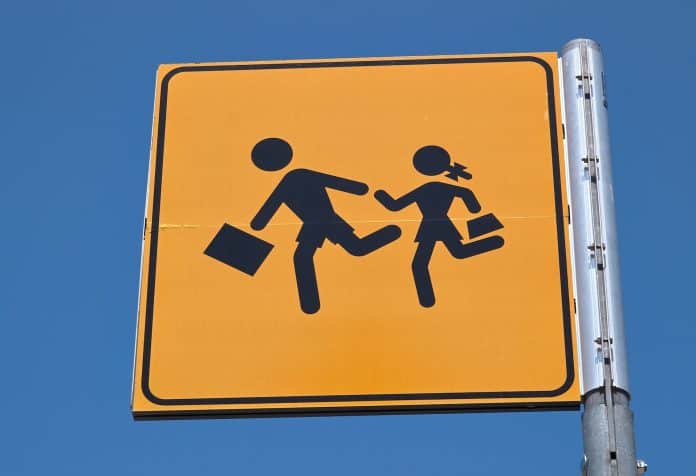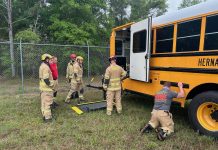Are more vigorous training and harsher penalties enough to prevent school bus stop incidents that are resulting in near misses, injuries and even death to students? That is a start, school bus safety experts told School Transportation News.
Pennsylvania saw its second student death-near incident at a Columbia County school bus stop at just after 7 a.m. local time last Wednesday. Five-year-old Silus Hunsinger was walking to his bus stop with an adult relative when he was struck by a pickup truck.
A spokesman for the State Police of Bloomsburg said that the location was a straight road and there were no adverse weather or road conditions. He added that the driver has not been arrested and that drugs, alcohol and speeding are not currently being considered a factor. The investigation is ongoing.
“I don’t know if the child was told it was clear, or whether the child just took it upon himself and ran out,” the spokesman said.
Local news reported that the boy attends Millville Elementary. A highlighted news item on the school’s website that bore no date—but seemed to be published in November—called attention to school bus safety “in light of recent bus stop incidents in the news.” It advised community members to be aware of school buses and the students who are often walking or crossing nearby.
But one expert stated that there may be something wrong with the way students are instructed to get to their school bus stops.
Related: School Bus Industry Addresses Illegal Passing Deaths
Related: School Bus Stop Safety: Why are Children Getting Hurt and Killed?
Ned Einstein, an expert witness, consultant, writer, and member of the STN editorial advisory board, said that he has seen most crossing deaths occur before or after the school bus gets to the stop rather than as a result of pass-bys. He is adamant that the level of training for school employees and students is “absolutely not” adequate.
Specifically, he shared that some districts try to reduce their liability by instructing students to arrive at the stop before the bus does, and leave the stop after the bus leaves—so if something happens, they won’t be responsible for it. That approach has killed thousands, he posited. Since the bus has the equipment to warn motorists that they need to stop for crossing kids, he questioned why districts would have kids crossing before it even gets there, or after it has left.
Safe crossing procedures are to be developed by each state, per the 2015 National School Transportation Specifications and Procedures manual. Training companies like School Bus Safety Company advise a thorough procedure, in which the school bus driver-guides students across while both parties attentively watch for approaching vehicles.
Richard Fischer, a former transportation director in California and currently an industry consultant, and Anna Borges, the state director of pupil transportation at the California Department of Education, confirmed that they strongly support the state’s method of crossing pre-kindergarten through eighth-grade students, as required by the California Highway Patrol.
Upon loading and unloading, the school bus driver must turn the bus ignition off, take the key with them, walk students into the road, and hold up a handheld stop sign while they finish crossing.
Einstein noted that Rhode Island has an attendant on the bus who carries out a similar function.
While police said the Columbia County, Pennsylvania incident was a tragic accident that may not have been preventable, governing authorities and law enforcement across the U.S. have been taking note of school bus safety. Some are stationing officers on buses or at stops to observe illegal passers, while others have released strongly-worded PSAs.
However, recent weeks saw a continuation of motorists endangering children by failing to take proper precautions around loading and unloading school buses. Even more alarming are the instances when it seems that adults just don’t care about student safety.
A teenage boy in Delaware was struck on Wednesday afternoon by a car that initially stopped for his school bus, but began driving again before the bus had turned off its flashing red lights. On Thursday, video captured a vehicle driving around a Wisconsin school bus on the right side, seconds after a student had just boarded. A Washington boy, who suffered broken bones after exiting the bus and being hit by an SUV, reported that the vehicle’s driver simply asked if he was okay and then left him in the road.
Incidents like these are why Einstein declares that nothing will change unless and until harsher penalties are put in place. While using stop-arm cameras or police involvement is a start, he said, “monitoring without enforcement is pointless.”
Both Fischer and Einstein have declared that they do not put much faith in the stop-arm cameras that various states and districts have implemented on their school buses. Use of the cameras “doesn’t solve a thing except you’ll be able to see the kid get hit with the car,” Fischer quipped.
Einstein told STN that he was concerned when stop-arm cameras first came out because he believed bus drivers would start relying too much on them rather than on their safety training. “It doesn’t matter how many robots you have in the mix—human beings have to do something,” he declared. He recounted that he participated in cases in which there was documentation of drivers notifying police of illegal passers and police responding that they would have to be present to make arrests. Using stop-arm cameras may even pose a problem since it requires more hours of admin time and does not always result in successful prosecution.
Likewise, legislation designed to reduce illegal passing has “to have a penalty and money to cover it.”
“Specific, tough things have to be done,” he said. “People are going to have to pay a price for this to go away.”
Einstein suggested two possible solutions.
One simple but creative idea is having a simple paintball fly onto any vehicle that passes a school bus that is properly stopped to load or unload students. This would pose an inconvenience to the driver, stigmatize them to the general public, and easily identify the car for legal penalties.
The second solution is simply getting tougher on illegal passers. Fines or license suspension, Einstein said, are “only going to work against poor people.” Jail time or negative, public news coverage, he suggested, are going to get people’s attention.
“If people pay, they’ll stop. You can’t get away from that principle. Serious problems deserve serious measures,” he stated. “If we’re not willing to take severe measure, we’re not going to get rid of this.”
Einstein admitted he takes a more pessimistic look at the topic due to the numerous lawsuits on which he has been an expert witness. But that is why he takes a non-negotiable stance on the fact that illegal school bus passing penalties should be much harsher.
“There are things that you could do to stop this,” he declared. “As a society, are we going to go far enough do to these things?”
















